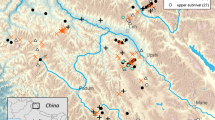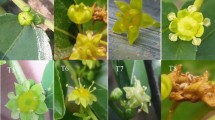Abstract
Asteroxylon mackiei was first described from the Rhynie Chert by Kidston and Lang1, but the nature of its reproductive region has remained uncertain, since the peculiar leafless axes and small pear-shaped sporangia, which they provisionally assigned to the plant, have never been found connected to its leafy stems.
This is a preview of subscription content, access via your institution
Access options
Subscribe to this journal
Receive 51 print issues and online access
$199.00 per year
only $3.90 per issue
Buy this article
- Purchase on Springer Link
- Instant access to full article PDF
Prices may be subject to local taxes which are calculated during checkout
Similar content being viewed by others
References
Kidston, R., and Lang, W. H., Trans. Roy. Soc. Edin., 52 (3) (1920).
Kräusel, R., and Weyland, H., Abh. senckenb. naturf. Ges., 40 (1926).
Scott, D. H., Studies in Fossil Botany (London, 1923).
Lang, W. H., and Cookson, I. C., Trans. Roy. Soc., B, 219 (1930).
Bower, F. O., Primitive Land Plants (London, 1935).
Author information
Authors and Affiliations
Rights and permissions
About this article
Cite this article
LYON, A. Probable Fertile Region of Asteroxylon mackiei K. and L.. Nature 203, 1082–1083 (1964). https://doi.org/10.1038/2031082b0
Issue Date:
DOI: https://doi.org/10.1038/2031082b0
Comments
By submitting a comment you agree to abide by our Terms and Community Guidelines. If you find something abusive or that does not comply with our terms or guidelines please flag it as inappropriate.



